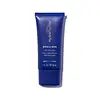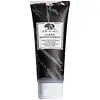What's inside
What's inside
 Key Ingredients
Key Ingredients

 Benefits
Benefits

 Concerns
Concerns

 Ingredients Side-by-side
Ingredients Side-by-side

Water
Skin ConditioningBentonite
AbsorbentGlycerin
HumectantHydrogenated Castor Oil
EmollientPropanediol
SolventCetyl Alcohol
EmollientGlyceryl Stearate
EmollientKaolin
AbrasiveStearic Acid
CleansingPEG-100 Stearate
Ricinus Communis Seed Oil
MaskingGlyceryl Caprylate
EmollientButyrospermum Parkii Butter
Skin ConditioningMenthyl Lactate
MaskingLecithin
EmollientDimethicone
EmollientLeuconostoc/Radish Root Ferment Filtrate
AntimicrobialPanthenol
Skin ConditioningTitanium Dioxide
Cosmetic ColorantCaprylyl Glycol
Emollient1,2-Hexanediol
Skin ConditioningButylene Glycol
HumectantXanthan Gum
EmulsifyingCarrageenan
Vaccinium Myrtillus Fruit Extract
Skin ConditioningPseudoalteromonas Ferment Extract
HumectantCamellia Sinensis Leaf Extract
AntimicrobialRosmarinus Officinalis Leaf Extract
AntimicrobialArctostaphylos Uva-Ursi Leaf Extract
Skin ConditioningCucumis Sativus Fruit Extract
EmollientTocopheryl Acetate
AntioxidantPEG-8
HumectantAminopeptidase
Skin ConditioningProtease
ExfoliatingSaccharum Officinarum Extract
MoisturisingTriethyl Citrate
MaskingCitric Acid
BufferingGlyceryl Undecylenate
EmollientHydrolyzed Wheat Protein
Skin ConditioningLavandula Angustifolia Flower/Leaf/Stem Extract
MaskingHydrolyzed Soy Protein
HumectantAcer Saccharum Extract
Skin ConditioningCitrus Aurantium Dulcis Fruit Extract
MaskingCitrus Medica Limonum Fruit Extract
Skin ConditioningCitrus Limon Peel Extract
EmollientSodium Hyaluronate
HumectantTetrahexyldecyl Ascorbate
AntioxidantPyrus Malus Fruit Extract
Skin ConditioningRubus Idaeus Fruit Extract
AstringentBupleurum Falcatum Root Extract
Skin ConditioningPotassium Sorbate
PreservativeAcetyl Hexapeptide-8
HumectantSalvia Officinalis Leaf Extract
CleansingUbiquinone
AntioxidantVanilla Planifolia Fruit Extract
Skin ConditioningTripeptide-10 Citrulline
Skin ConditioningCarbomer
Emulsion StabilisingCaffeine
Skin ConditioningCoenzyme A
Skin ConditioningSalvia Sclarea Extract
AntiseborrhoeicVaccinium Macrocarpon Fruit Extract
AstringentZingiber Officinale Root Extract
MaskingTripeptide-1
Skin ConditioningWater, Bentonite, Glycerin, Hydrogenated Castor Oil, Propanediol, Cetyl Alcohol, Glyceryl Stearate, Kaolin, Stearic Acid, PEG-100 Stearate, Ricinus Communis Seed Oil, Glyceryl Caprylate, Butyrospermum Parkii Butter, Menthyl Lactate, Lecithin, Dimethicone, Leuconostoc/Radish Root Ferment Filtrate, Panthenol, Titanium Dioxide, Caprylyl Glycol, 1,2-Hexanediol, Butylene Glycol, Xanthan Gum, Carrageenan, Vaccinium Myrtillus Fruit Extract, Pseudoalteromonas Ferment Extract, Camellia Sinensis Leaf Extract, Rosmarinus Officinalis Leaf Extract, Arctostaphylos Uva-Ursi Leaf Extract, Cucumis Sativus Fruit Extract, Tocopheryl Acetate, PEG-8, Aminopeptidase, Protease, Saccharum Officinarum Extract, Triethyl Citrate, Citric Acid, Glyceryl Undecylenate, Hydrolyzed Wheat Protein, Lavandula Angustifolia Flower/Leaf/Stem Extract, Hydrolyzed Soy Protein, Acer Saccharum Extract, Citrus Aurantium Dulcis Fruit Extract, Citrus Medica Limonum Fruit Extract, Citrus Limon Peel Extract, Sodium Hyaluronate, Tetrahexyldecyl Ascorbate, Pyrus Malus Fruit Extract, Rubus Idaeus Fruit Extract, Bupleurum Falcatum Root Extract, Potassium Sorbate, Acetyl Hexapeptide-8, Salvia Officinalis Leaf Extract, Ubiquinone, Vanilla Planifolia Fruit Extract, Tripeptide-10 Citrulline, Carbomer, Caffeine, Coenzyme A, Salvia Sclarea Extract, Vaccinium Macrocarpon Fruit Extract, Zingiber Officinale Root Extract, Tripeptide-1
Water
Skin ConditioningMyrtus Communis Leaf Water
MaskingKaolin
AbrasiveBentonite
AbsorbentButylene Glycol
HumectantMontmorillonite
AbsorbentPolysorbate 20
EmulsifyingPEG-100 Stearate
Charcoal Powder
AbrasiveXanthan Gum
EmulsifyingLecithin
EmollientPEG-150 Distearate
EmulsifyingPropylene Glycol Stearate
Skin ConditioningSorbitan Laurate
EmulsifyingGlycerin
HumectantPropylene Glycol Laurate
Skin ConditioningSimethicone
EmollientCaprylyl Glycol
EmollientEthylhexylglycerin
Skin ConditioningHexylene Glycol
EmulsifyingTrisodium EDTA
Dehydroacetic Acid
PreservativePhenoxyethanol
PreservativeWater, Myrtus Communis Leaf Water, Kaolin, Bentonite, Butylene Glycol, Montmorillonite, Polysorbate 20, PEG-100 Stearate, Charcoal Powder, Xanthan Gum, Lecithin, PEG-150 Distearate, Propylene Glycol Stearate, Sorbitan Laurate, Glycerin, Propylene Glycol Laurate, Simethicone, Caprylyl Glycol, Ethylhexylglycerin, Hexylene Glycol, Trisodium EDTA, Dehydroacetic Acid, Phenoxyethanol
 Reviews
Reviews

Ingredients Explained
These ingredients are found in both products.
Ingredients higher up in an ingredient list are typically present in a larger amount.
Bentonite is an aluminium phyllosilicate clay with great absorbent properties. The name 'bentonite' comes from the area where the largest source is found: Fort Benton, Wyoming.
As a clay, bentonite is often used to absorb excess oil and provide exfoliation. It has also been shown to have some antibacterial and anti-inflammatory properties. Studies show bentonite was effective at calming dermatitis from poison ivy and in diaper dermatitis of infants. Bentonite has also been shown to act as a barrier against toxic compounds on your skin.
Sunscreens containing bentonite display higher water resistance and stay on the skin for much longer. The sunscreens containing bentonite also show higher potency and UV light absorbtion.
Bentonite is naturally created from volcanic ash and several natural weathering/hydrothermal processes.
A common usage of bentonite is removing excess protein from white wines. Bentonite contains a property of being able to absorb large amounts of protein from aqueous solutions.
Phyllosilicate clay has a structure formed by sheets.
Learn more about BentoniteButylene Glycol (or BG) is used within cosmetic products for a few different reasons:
Overall, Butylene Glycol is a safe and well-rounded ingredient that works well with other ingredients.
Though this ingredient works well with most skin types, some people with sensitive skin may experience a reaction such as allergic rashes, closed comedones, or itchiness.
Learn more about Butylene GlycolCaprylyl Glycol is a humectant and emollient, meaning it attracts and preserves moisture.
It is a common ingredient in many products, especially those designed to hydrate skin. The primary benefits are retaining moisture, skin softening, and promoting a healthy skin barrier.
Though Caprylyl Glycol is an alcohol derived from fatty acids, it is not the kind that can dry out skin.
This ingredient is also used as a preservative to extend the life of products. It has slight antimicrobial properties.
Learn more about Caprylyl GlycolGlycerin is already naturally found in your skin. It helps moisturize and protect your skin.
A study from 2016 found glycerin to be more effective as a humectant than AHAs and hyaluronic acid.
As a humectant, it helps the skin stay hydrated by pulling moisture to your skin. The low molecular weight of glycerin allows it to pull moisture into the deeper layers of your skin.
Hydrated skin improves your skin barrier; Your skin barrier helps protect against irritants and bacteria.
Glycerin has also been found to have antimicrobial and antiviral properties. Due to these properties, glycerin is often used in wound and burn treatments.
In cosmetics, glycerin is usually derived from plants such as soybean or palm. However, it can also be sourced from animals, such as tallow or animal fat.
This ingredient is organic, colorless, odorless, and non-toxic.
Glycerin is the name for this ingredient in American English. British English uses Glycerol/Glycerine.
Learn more about GlycerinKaolin is a clay. It is used for oil control and to help minimize pores. Like other clays, kaolin has the ability to absorb excess sebum or oil. This can help clean out pores and mattify the skin.
Some types of kaolin may have exfoliating properties. When water is added to kaolin, it becomes a paste with small abrasive particles.
Most kaolin is a white color, but may be pink/orange/red depending on where it comes from.
The name 'kaolin' comes from a Chinese village named 'Gaoling'. Kaolin clay comes from rocks rich in kaolinite. Kaolinite, the mineral, has a silicate layered structure. Kaolinite is formed from chemical weathering of aluminum siilicate minerals.
Besides skincare, kaolin is commonly used to make glossy paper, in ceramics, toothpaste, and as medicine to soothe stomach issues.
Learn more about KaolinLecithin is a term for a group of substances found in the cell membranes of plants, animals, and humans. They are made up of mixture of phospholipids.
This ingredient has emollient and emulsifying properties.
As an emollient, lecithen helps soften the skin and creates a barrier to keep moisture in.
As an emulsifier, it also helps prevent water and oil ingredients from separating. Lecithin can also help ingredients be better absorbed by the skin.
This is because the phospholipids in lecithin produce liposomes. Liposomes help other ingredients get through the skin barrier.
Depending on the source of this ingredient, lecithin may not be fungal acne safe. This is because some sources of lecithin come from soybean oil, which may feed the malassezia yeast that feeds fungal acne.
We recommend reaching out to the brand you are purchasing from to inquire about the source of their lecithin.
Some other names for this ingredient include soy lecithin and deoiled soy lecithin.
Learn more about LecithinPeg-100 Stearate is an emollient and emulsifier. As an emollient, it helps keep skin soft by trapping moisture in. On the other hand, emulsifiers help prevent oil and water from separating in a product.
PEGS are a hydrophilic polyether compound . There are 100 ethylene oxide monomers in Peg-100 Stearate. Peg-100 Stearate is polyethylene glycol ester of stearic acid.
Water. It's the most common cosmetic ingredient of all. You'll usually see it at the top of ingredient lists, meaning that it makes up the largest part of the product.
So why is it so popular? Water most often acts as a solvent - this means that it helps dissolve other ingredients into the formulation.
You'll also recognize water as that liquid we all need to stay alive. If you see this, drink a glass of water. Stay hydrated!
Learn more about WaterXanthan gum is used as a stabilizer and thickener within cosmetic products. It helps give products a sticky, thick feeling - preventing them from being too runny.
On the technical side of things, xanthan gum is a polysaccharide - a combination consisting of multiple sugar molecules bonded together.
Xanthan gum is a pretty common and great ingredient. It is a natural, non-toxic, non-irritating ingredient that is also commonly used in food products.
Learn more about Xanthan Gum